The secret to avoiding a dry turkey? Try this Georgia chef's method for Thanksgiving
- Oops!Something went wrong.Please try again later.
"I can't imagine cutting a turkey without brining it first," says Brandon Carter, executive chef and partner in FARM Hospitality ― the suite of farmer-forward restaurants FARM Bluffton, Common Thread, Strangebird, and Wildflower Café. "I feel like the outcome would just be sawdust."
Before us is a 17-pound bird that reclined for 16 hours in a saltwater bath of citrus, peppercorns, coriander, ginger and other spices and seasonings (recipe below). Those nuanced flavors, especially the ginger, play well with others indicative of the season such as sage, he explains, and gets carried through sides and desserts like cornbread dressing, sweet potatoes and pumpkin pie.
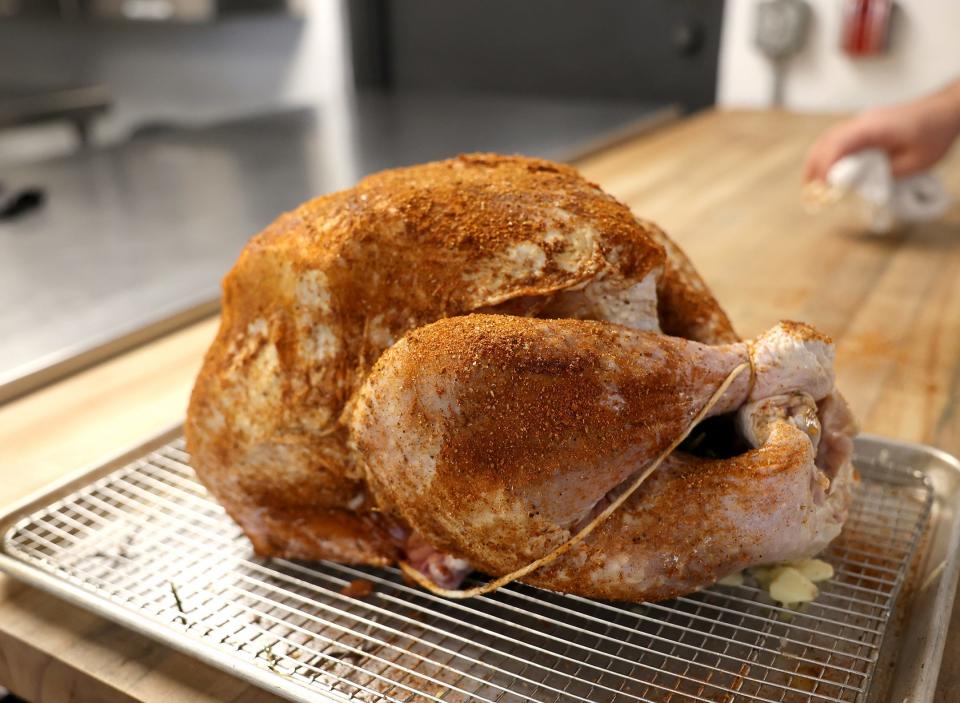
The bird is pale and plump and curvy like the idealized women of Renaissance paintings, which makes sense given Carter's artful approach to thoughtful and well-grown ingredients and their preparation. But there is not one whiff of snobbery. "This recipe is good for the Butterball that you might get at Publix down the road or the farm turkey from the guy at the farmers' market." It's scalable, too, for a smaller bird or a roast chicken.
Instead of rinsing off the bathing beauty after its submersion, he lets it air dry in the 'fridge overnight. "What happens then is the salt interacts with the protein and kind of draws the proteins to the surface of the meat. When that dries, it kind of gets a little bit tacky," which makes it a blank canvas on which to make the "smoke stick."
From there, Carter takes me step by step through his process to achieve both juicy meat and crispy, crispy skin, which we've established at this point is the goal.
"What we're all trying to get is, we're trying to cook a better turkey than our neighbors," he says with a mischievous laugh.
Step 1. Stuff the Cavity and Remove the Wings
Carter grabs a bouquet of fresh rosemary, thyme and basil, and fills the bird's cavity. "It can be sage. You can put tarragon in here. You can put some Italian parsley, you know, whatever you like."
He then uses a sharp knife to cut through the joint to separate the wings. "I really like to take the wings and treat them a little different," he says, recommending cooking them separately or using them in a stock.
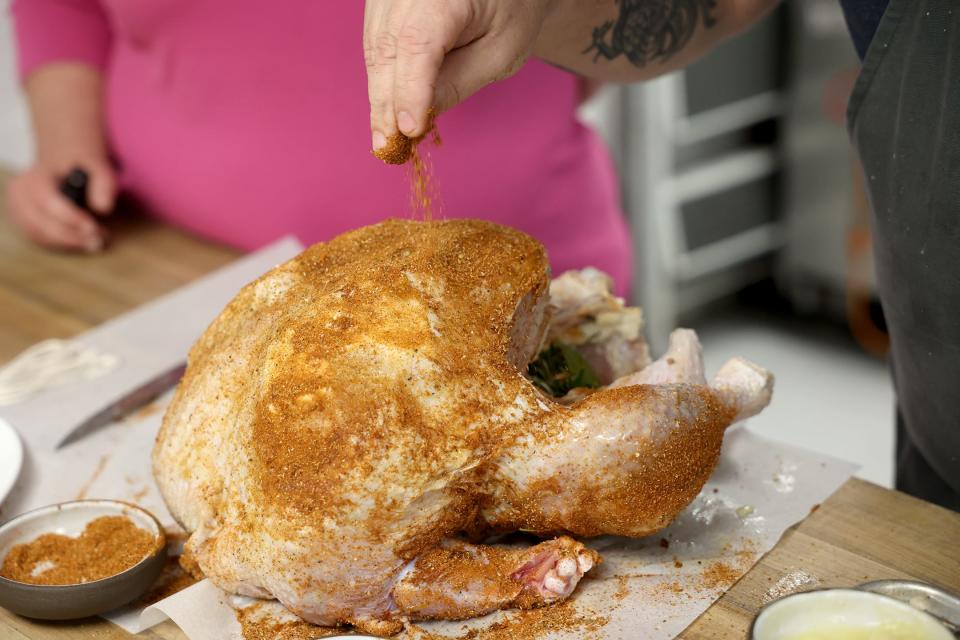
Step 2. Butter and More Butter
With his fingers, Carter separates the skin from the bird's flesh then packs barely softened tablespoons of butter in the air pockets. This step achieves two important outcomes: 1) the butter bastes the bird as it melts and 2) "it's like the Peking duck-effect," whereby the air gap crisps the underside of the skin at the same time the smoke and the heat crisp the top, creating a golden, shattering crunch.
Carter muses that you can use a compound butter with garlic and other aromatics. He says a French chef he knows stuffs foie gras under the skin. "Chicken liver, turkey liver... It's your bird, so do what you want." He heartily encourages all to play with their food.
From a bowl, Carter scoops butter that has been melted and infused with smashed garlic cloves then re-solidified and softened. He massages the garlic butter in every "crook and nannie" all over the turkey. The massage is not only going to add deeper flavor, "it's going to help give this boy a suntan." Butter as culinary equivalent to Banana Boat.
Step 3. The Spice Rub
Carter's unabashed generosity with the butter is matched by his liberal dusting of a house-made rib rub all over the outside of the turkey and inside its cavity. The butter acts as an adhesive, holding tightly to all the smoky sweetness from the paprika, coriander, fennel and brown sugar, among other spices.
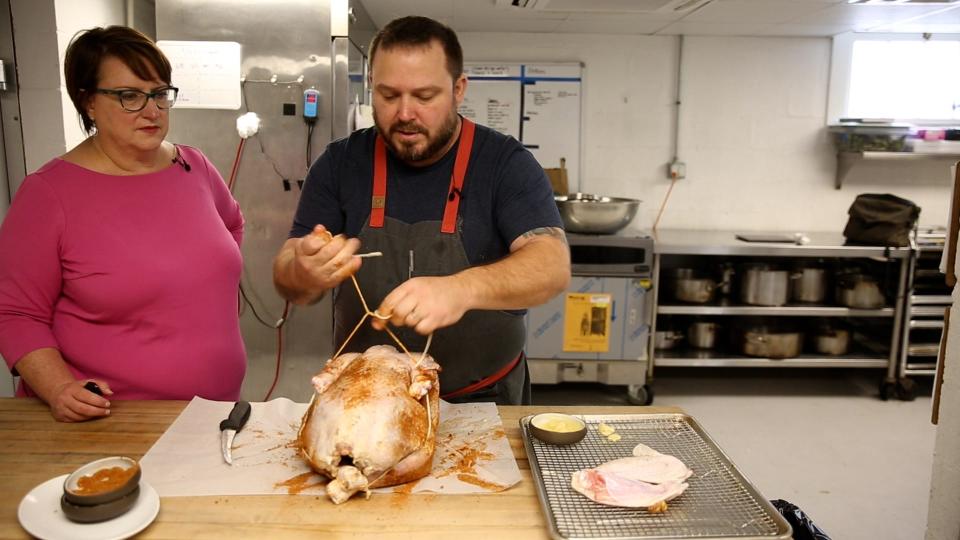
Step 4. Truss that Baby
Using cooking string, Carter ties the bird up tight, using a locking ― or butcher's ― knot.
Step 5. Into the Smoker
Carter's prefers white oak and throws another log in the fire box to make sure he keeps the smoker as close to a constant 275° F for the next four hours to fully cook the turkey to an internal temperature of 155° F. While the bird self-bastes low and slow, he focuses on the sides.
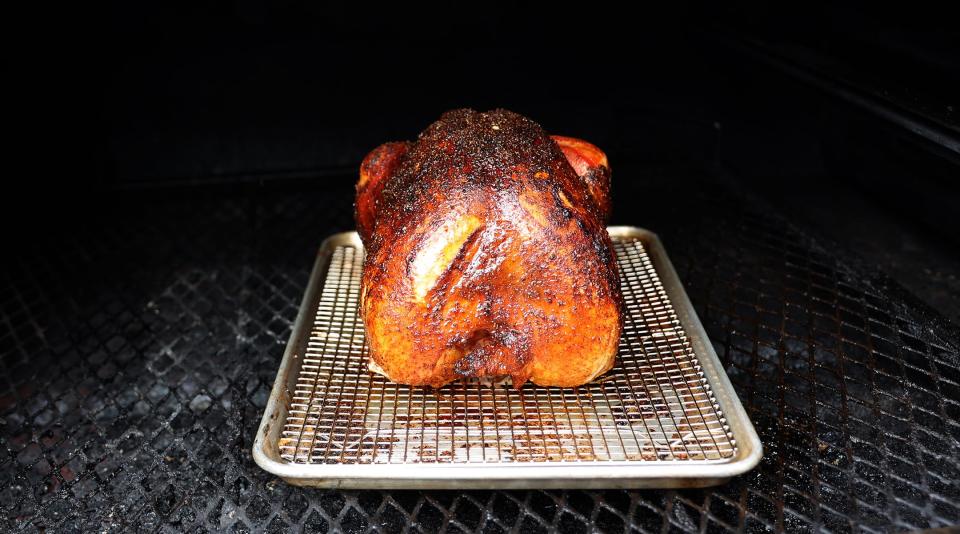
"I'm a softy for casseroles," he admits. "Squash casserole, broccoli casserole, green beans with mushroom soup and crispy onions on top. Thanksgiving is for nostalgia."
And crispy skin?
He nods. "And crispy skin."
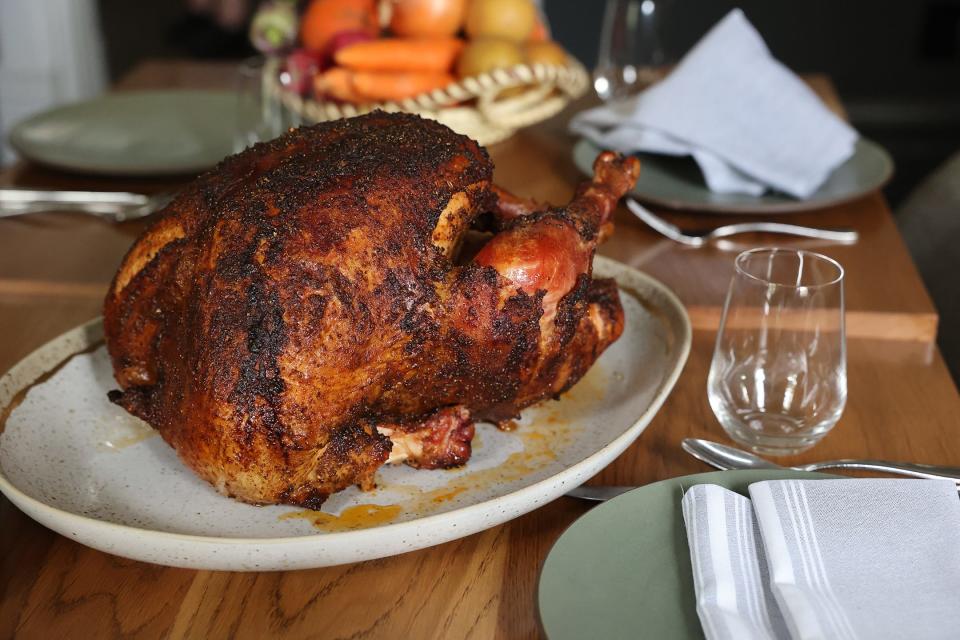
Chef Brandon Carter's Turkey Brine
3 oranges, sliced
3 lemons, sliced
8-ounce knob of ginger, peeled and sliced into 2-3 pieces
30 garlic cloves, peeled and smashed
25 bay leaves
1 bunch fresh thyme
8 sprigs fresh rosemary
3 tablespoons black peppercorns
2 gallons, plus 1 quart water, divided
2 cups kosher salt
12 to 17-pound fresh or thawed turkey, rinsed and patted dry inside and out
Combine the orange, lemon, ginger, garlic, bay leaves, rosemary, thyme, peppercorns and 1 quart of water in a medium saucepan and bring to a simmer over medium heat. Add the salt and simmer, stirring, until the salt is dissolved, approximately 5 minutes.
Remove the saucepan from the heat and stir the mixture into 2 gallons water, then set aside to cool completely.
Set the turkey in a container, such as a large stockpot or ceramic container that can hold both the turkey and the brining liquid. Pour the cooled brine over the turkey, set the pot in the refrigerator and let the turkey brine for 16 hours.
Remove the turkey from the brine, pat it dry, then place it on a wire rack over a cookie sheet to rest in the refrigerator at least 8 hours or overnight.
Prepare your smoker according to manufacturer's instructions to 275° F.
When ready to smoke, fill the cavity of the turkey with fresh herbs, rub softened butter under the skin and over the top of the turkey. Sprinkle the entire outside of the turkey with salt and pepper or your favorite meat rub or blackening seasoning.
Smoke (or roast) the turkey for approximately 4 hours, or until the internal temperature reaches 155° F. Remove the turkey and wrap loosely with aluminum foil. Let the turkey rest for 30 minutes before carving.
This article originally appeared on Savannah Morning News: How to smoke a turkey: A Georgia chef's expert tips for Thanksgiving

